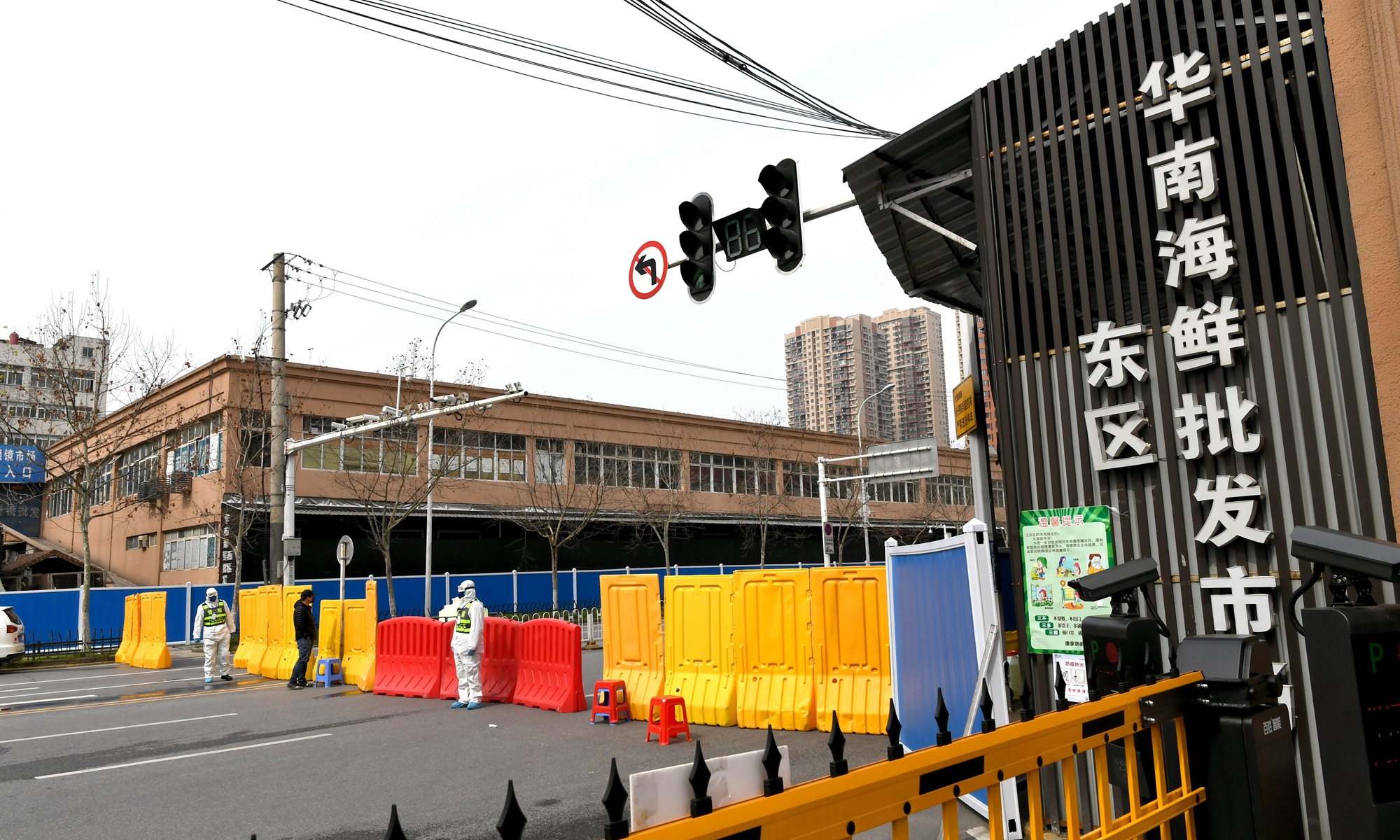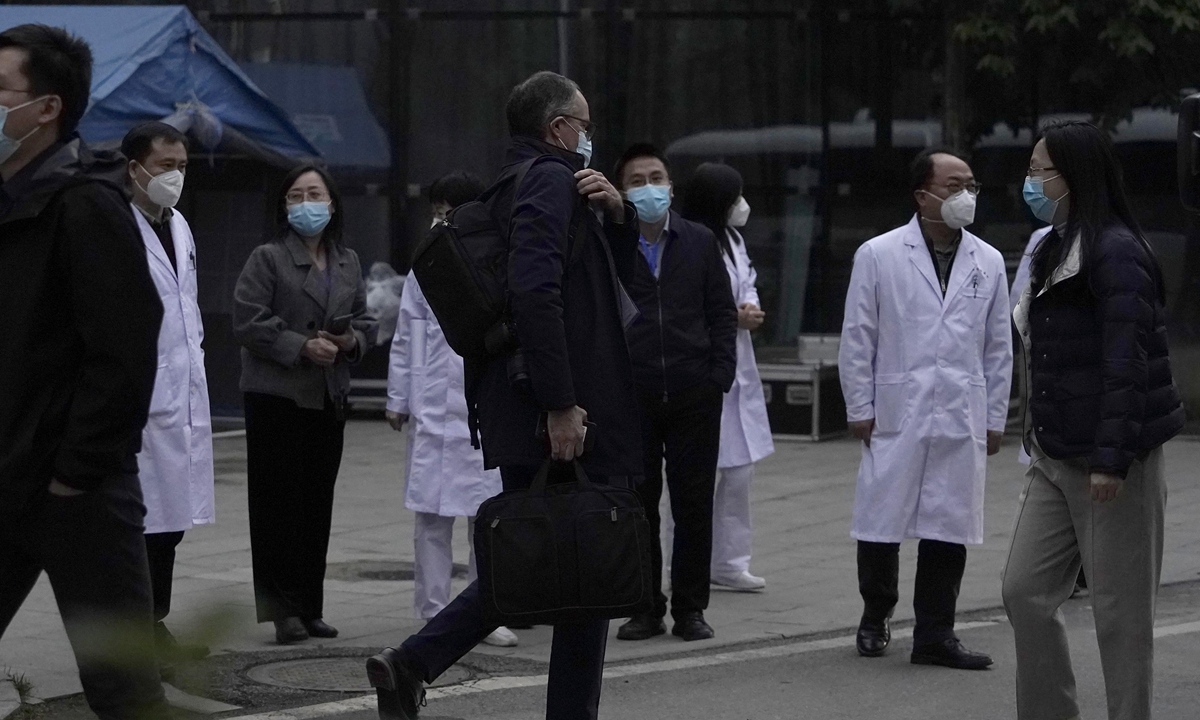
The Huanan Seafood Market Photo: Courtesy to Xiao Meng
For residents who live near the Huanan Seafood Market in Hankou district of Wuhan, their ritual of buying food and fruits from there in preparation for the Spring Festival holiday has to be altered this year. Since being suspended on January 1, 2020, the market, which was closely linked to the first batch of patients infected with the novel coronavirus in China, has been sealed off for a year.
It is expected to see the WHO expert team soon. After a 14-day-quarantine in Wuhan, the team of 13 scientists, on the mission to study the origins of the coronavirus starting Friday, have scheduled to visit Huanan Seafood Market and local hospitals and have face-to-face meetings with Chinese scientists in Wuhan.
Peter Ben Embarek, who leads the WHO team, told the Global Times that although the Huanan market has been sealed off, the experts believe that there is still plenty to see and experience there.
"[We hope to] understand the setting, see the places where cases were linked, reconstruct the initial event there, search for records of animals and products traded there, and possibly talk to some of the merchants who were there at that time," Embarek said.
Being sealed off for more than a year, what kind of information could the Huanan Seafood Market offer to the WHO expert team? Whether tracing the first batch of patients who had exposure to the market would shed light on the origin of the virus, or on how the virus jumped from animals to humans?

Staff members disinfect the Huanan Seafood Market in Wuhan, March 2020. Photo: cnsphoto
A central topic
Located less than 1.2 kilometers away from the Hankou Railway Station, the Huanan Seafood Market used to see heavy traffic jams and huge crowds, especially before Spring Festival holidays.
Now, it is shielded away from the outside with light blue barricades. Its previous signboard has been removed and a new door, which is hard to find, is closed all day. Passers-by could still smell the disinfectant from inside the market in front of the door.
At the early stage of the coronavirus outbreak in Wuhan, some people thought the market was the "original" place where the virus jumped from animals to humans as wildlife animals were reportedly sold here, and many early patients were linked to it. Other conspiracy theories centering on the market were also spread.
However, subsequent investigations have shaken the hypothesis. Wu Zunyou, chief epidemiologist of the Chinese Center for Disease Control and Prevention, told a forum in November 2020 that on December 31, 2019, Wuhan reported 41 patients, who were the first batch of infections of the coronavirus, and among them, 27 were linked to the seafood market and the others had no exposure history to the market.
A group of scientists in Shanghai also found that Huanan may not be the origin of the coronavirus. A peer-reviewed paper published online by Nature in May 2020 showed that these scientists collected viral genome samples from 326 patients in Shanghai between January 20 and February 25. They identified two major clusters from people who had exposure to the market and who had not, both of whom included cases diagnosed in early December 2019.
Lu Hongzhou, an expert from the Public Health Clinical Center affiliated to Fudan University and also a member of the Shanghai team, was cited by Caijing magazine in November 2020 that Chinese scientists had found coronavirus-positive environment samples from the Huanan Seafood Market but did not isolate the virus from wild animals at the market, suggesting the market was a super-spreader rather than the origin of the virus.
A vendor who used to sell frozen meat from Huanan told the Global Times that he was already placed under quarantine when the market was closed on January 1, 2020. "There was occasional selling of wild animals, but not prevalent."
No bat has been sold in the market or eaten in Wuhan, he said, refuting rumors that the epidemic was caused by local residents eating bats.
"Previously, we thought maybe it was related to the wild animals. But after more and more flare-ups were caused by imported seafood, I began to wonder maybe I was wrong," he said, noting that vendors selling frozen meat and aquatic products were concentrated in the western section of the market.
Experts from China's CDC went to the market twice in January. From the 585 samples they took, 33 were tested positive, and 31 of them were from the west section.
The vendor is not the only one who questioned the hypothesis that the outbreak may have been caused by eating wild animals like bats or pangolin. The Global Times has learned from sources that food and market supervision authorities in Wuhan had strengthen management and food safety for the World Military World Games, which was held in October 2020 in Wuhan. Wild animal trading in Huanan was also under strict supervision before the outbreak at the end of December 2020.
The vendor also said that US participants in the Military World Games stayed in a hotel very close to the market. "Maybe the experts should also investigate the hotel they stayed in."

Wuhan
What to see?
As the first place to spot cluster infections, the Huanan Seafood Market may offer the WHO team more information on the early patients and on whether these patients were domestically infected or from imported cases or items, Jin Dongyan, a professor at the School of Biomedical Sciences at the University of Hong Kong, told the Global Times.
Jin said that China's support to WHO experts' trips in China shows China's open and transparent attitude toward the origin-seeking mission.
"Hoping to find the coronavirus origin in Wuhan or in the Huanan market would be impossible as the US and the EU have different virus genome sequences with China. The mission should be conducted in various countries at the same time," Yang Zhanqiu, a deputy director of the pathogen biology department at Wuhan University, told the Global Times.
"The Huanan Seafood Market may also offer some clues to the WHO team on the virus transmission pattern. But the animal origin of the virus is still unknown and needs efforts from global scientists," Yang said.
Yang noted that Shi Zhengli, a leading virologist from the Wuhan Institute of Virology, who was dubbed "Bat Woman" due to her years of research and achievements in research with bats and viruses, and her colleagues are working on trying to find the animal origin of the novel coronavirus and how it jumped from animals to humans.
Aside from the seafood market, Embarek told the Global Times that the WHO team also plans to visit hospitals, including Jinyintan Hospital, as they were the first to receive COVID-19 patients at the beginning of the outbreak in Wuhan, and would talk to scientists from the Wuhan Institute of Virology.

Peter Ben Embarek (center) of the World Health Organization research team passes by Chinese doctors during a visit to the Hubei Provincial Hospital of Integrated Chinese and Western Medicine, also known as the Hubei Province Xinhua Hospital, in Wuhan, Central China's Hubei Province on Friday. Photo: AP
Next stepWhile WHO experts are working in Wuhan, scientists have found that bats that lived in a Cambodian cave in 2010 carried a pathogen that is "nearly identical" to the virus that causes COVID-19. Samples the scientists tested have been stored in a freezer at the Pasteur Institute in Phnom Penh, Cambodia.
By sequencing samples from 430 bats gathered more than a decade ago, these scientists found viruses "nearly identical" to the one that causes COVID-19 in two Rhinolophus shameli bats, known as Shemal's horseshoe bats, which are found in Cambodia, Laos, Myanmar, Thailand and Vietnam, Sky News reported on Thursday.
Shi's team found that the genomic sequence of the virus, eventually named SARS-CoV-2, was 96 percent identical to that of a coronavirus the researchers had identified in horseshoe bats in Yunnan Province. Their results appeared in a paper published online on February 3 in Nature magazine.
"It's crystal clear that bats, once again, are the natural reservoir," said disease ecologist Peter Daszak, president of EcoHealth Alliance, a New York City-based nonprofit research organization that collaborates with researchers, such as Shi, in 30 countries in Asia, Africa and the Middle East to discover new viruses in wildlife.
No conclusion on the animal origin of the coronavirus has been made as the current research is largely based on previous research on SARS. Seeking virus origins is not easy, and needs the efforts of global scientists without political interference, Yang said.
Xiao Meng also contributed to the story







